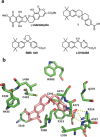Designed Spiroketal Protein Modulation
- PMID: 28407400
- PMCID: PMC5435924
- DOI: 10.1002/anie.201612504
Designed Spiroketal Protein Modulation
Abstract
Spiroketals are structural motifs found in many biologically active natural products, which has stimulated considerable efforts toward their synthesis and interest in their use as drug lead compounds. Despite this, the use of spiroketals, and especially bisbenzanulated spiroketals, in a structure-based drug discovery setting has not been convincingly demonstrated. Herein, we report the rational design of a bisbenzannulated spiroketal that potently binds to the retinoid X receptor (RXR) thereby inducing partial co-activator recruitment. We solved the crystal structure of the spiroketal-hRXRα-TIF2 ternary complex, and identified a canonical allosteric mechanism as a possible explanation for the partial agonist behavior of our spiroketal. Our co-crystal structure, the first of a designed spiroketal-protein complex, suggests that spiroketals can be designed to selectively target other nuclear receptor subtypes.
Keywords: drug design; drug discovery; natural products; spiro compounds; structure elucidation.
© 2017 The Authors. Published by Wiley-VCH Verlag GmbH & Co. KGaA.
Figures




Similar articles
-
Enantioselective access to benzannulated spiroketals using a chiral sulfoxide auxiliary.Org Biomol Chem. 2013 Aug 21;11(31):5147-55. doi: 10.1039/c3ob41065j. Epub 2013 Jul 2. Org Biomol Chem. 2013. PMID: 23817587
-
Stereocontrol of 5,5-spiroketals in the synthesis of cephalosporolide H epimers.Org Lett. 2010 Oct 15;12(20):4698-701. doi: 10.1021/ol102201z. Org Lett. 2010. PMID: 20860404
-
Structure, energetics, and dynamics of binding coactivator peptide to the human retinoid X receptor α ligand binding domain complex with 9-cis-retinoic acid.Biochemistry. 2011 Jan 11;50(1):93-105. doi: 10.1021/bi101288y. Epub 2010 Dec 8. Biochemistry. 2011. PMID: 21049972 Free PMC article.
-
Benzannulated spiroketal natural products: isolation, biological activity, biosynthesis, and total synthesis.Org Biomol Chem. 2019 Sep 28;17(36):8272-8307. doi: 10.1039/c9ob01598a. Epub 2019 Sep 3. Org Biomol Chem. 2019. PMID: 31478048 Review.
-
Nitroalkanes as central reagents in the synthesis of spiroketals.Molecules. 2008 Feb 7;13(2):319-30. doi: 10.3390/molecules13020319. Molecules. 2008. PMID: 18305420 Free PMC article. Review.
References
-
- Zheng Y., Tice C. M., Singh S. B., Bioorg. Med. Chem. Lett. 2014, 24, 3673–3682. - PubMed
-
- Perron F., Albizati K. F., Chem. Rev. 1989, 89, 1617–1661.
-
- Sperry J., Wilson Z. E., Rathwell D. C. K., Brimble M. A., Nat. Prod. Rep. 2010, 27, 1117–1137. - PubMed
-
- Yoneda N., Fukata Y., Asano K., Matsubara S., Angew. Chem. Int. Ed. 2015, 54, 15497–15500; - PubMed
- Angew. Chem. 2015, 127, 15717–15720.
-
- Butler B. B., Manda J. N., Aponick A., Org. Lett. 2015, 17, 1902–1905. - PubMed
Publication types
MeSH terms
Substances
LinkOut - more resources
Full Text Sources
Other Literature Sources

